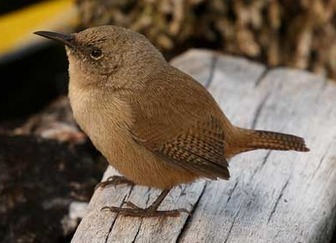Troglodytes cobbi
The plumage is brown, greyer on the head and breast and more rufous on the tail. There are dark bars on the flight feathers and tail. The bill is long, blackish and slightly curved. The main confusion species is the Grass Wren which is smaller with a shorter bill, buff eyestripe and dark streaks on the back and head. Cobb's Wrens have a number of buzzing calls and their song is a series of jumbled trills and whistles. The song can be heard from August to February and varies between individuals with different males having different song patterns.

Original source: User:GeForce3
Author: User:GeForce3
The Troglodytes cobbi is classified as Vulnerable (VU), considered to be facing a high risk of extinction in the wild.
* Cobb's Wren, Troglodytes cobbi - formerly included in T. More
Troglodytes cobbi (Cobb’s wren) is a wren found only in the Falkland islands. Troglodytes cobbi is named Cobb’s wren after Arthur F. Cobb who collected the first specimen from which the species was described on Carcass Island, Falkland Islands, in July 1908. More
Background: The species Troglodytes cobbi was described and named by Chubb (1909) the year after the type specimen was collected by Arthur Cobb. Rollo Beck, who collected specimens for the AMNH between 6 November 1915 and 13 January 1916, remarked on the ‘quite noticeable’ absence of land birds and heard from the Colonial Secretary, who gave him a collecting permit, that the wren was ‘very rare’. More
Range & population Troglodytes cobbi has a very scattered distribution in the Falkland Islands (Malvinas). Surveys in 1983/1984-1992/1993 indicated breeding on 12 offshore islands and islets, and estimated the total population at 1,300-2,400 pairs4. Surveys have indicated breeding on 35 islands7, and estimated the total population at 4,500-8,000 pairs3,5. Most of the islands are in small groups, separated by up to 64 km of sea, and there is no evidence to suggest an interchange between these island populations2,4. More
Taxonomy: Troglodytes cobbi Chubb, 1909, Carcass Island, north-west of West Falkland, Falkland Islands. Forms a superspecies with T. aedon, T. brunneicollis, T. musculus, T. tanneri and T. beani, and all often treated as conspecific. Present species distinct from others, however, in large size, different plumage and markedly different ecology. Monotypic. Distribution: Small offshore islands in Falkland Is. More
Family : Troglodytidae
Genus : Troglodytes
Species : cobbi
Authority : Chubb, 1909
